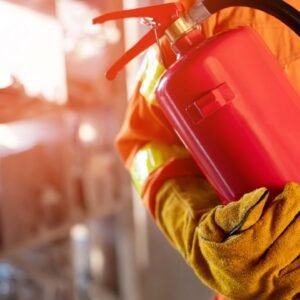Living and working in London comes with a vibrant atmosphere, but fire safety remains paramount. As a responsible property owner, you understand the importance of obtaining a fire risk certificate, also known as a fire safety certificate. This document demonstrates your commitment to fire safety regulations and ensures the well-being of everyone in your building.
However, navigating the application process for a fire risk certificate can be tricky, especially with London’s diverse range of properties. Let’s delve into some common mistakes applicants make and how to avoid them, ensuring a smooth and successful application.
1. Confusing a Fire Risk Assessment with a Fire Risk Certificate
Fire risk assessment and fire risk certificate – these terms sound similar, but they serve distinct purposes. A fire risk assessment (FRA) is a comprehensive evaluation that identifies potential fire hazards in your building, assesses the risks they pose, and outlines necessary mitigation measures. It’s the foundation for a safe environment.
The fire risk certificate (FRC), on the other hand, is a formal document issued by a competent person after reviewing your FRA. It confirms you’ve taken adequate steps to minimize fire risks based on the assessment findings.
In essence, the FRA is the groundwork, while the FRC is the official stamp of approval. Don’t confuse the two – you’ll need a completed fire risk assessment before applying for the certificate.
2. Not Understanding the “Responsible Person” Role
The fire safety order dictates that every premises in the UK must have a designated “responsible person.” This individual is legally accountable for upholding fire safety within the building. This role typically falls on the owner, but it can also be delegated to someone else, such as a managing agent.
Understanding this responsibility is crucial. When applying for your fire risk certificate, ensure the designated responsible person is clearly identified in your application and fire risk assessment. This demonstrates your awareness of the legal obligations and commitment to fire safety.
3. Failing to Conduct a Thorough Fire Risk Assessment
A fire risk assessment is not a tick-box exercise. A comprehensive and competent assessment forms the basis for a strong application and, more importantly, a truly safe environment. Here are some key aspects of a thorough FRA:
- Identifying Fire Hazards: This involves a meticulous examination of your property, considering electrical wiring, gas appliances, combustible materials, and any potential ignition sources.
- Assessing Risks: Once hazards are identified, the assessment evaluates the severity of the risk they pose. Factors like the likelihood of ignition, potential for rapid fire spread, and the number of occupants all play a role.
- Recommending Measures: Based on the risk assessment, your FRA should outline a clear plan to mitigate these hazards. This might involve installing fire alarms, improving escape routes, or implementing fire safety training for occupants.
Remember, a thorough FRA is not just about obtaining a certificate; it’s about creating a genuinely fire-safe environment for everyone in the building.
Fire Risk Certificate London for Landlords
As a landlord, it’s your responsibility to ensure your property is safe for tenants, and a fire risk certificate London is the first step. At All Landlord Certificates, we specialize in helping landlords meet their legal fire safety obligations. Our fire risk assessments are thorough, identifying hazards and providing solutions to ensure compliance. Once complete, you’ll receive a fire risk certificate London, proving that your property meets the required safety standards. Let us help you keep your tenants and property safe.
4. Underestimating the Complexity of Your Building
London boasts a diverse range of properties, from historic buildings to modern high-rises. The complexity of your building can significantly impact the fire risk assessment and application process. Here’s what to consider:
- Layout and Occupancy: Is it a single-family home, a multi-occupancy building, or a commercial space? Each type presents unique fire risks based on layout, occupant numbers, and usage.
- Fire Safety Features: Existing fire safety measures like sprinklers, alarms, and compartmentation should be documented in your assessment.
- Special Considerations: Historical buildings may require additional fire safety measures due to their construction materials or layout.
By acknowledging the complexity of your building, you can ensure a more accurate and effective fire risk assessment, ultimately strengthening your application.
5. Neglecting to Regularly Review and Update Your FRA
Fire safety is an ongoing process, not a one-time fix. The fire risk assessment you conduct today might not reflect the situation a year from now. Here’s why regular reviews are crucial:
- Changes in Occupancy: If you have tenant turnover or changes in building usage, it’s essential to re-evaluate potential fire risks.
- Upgrades and Renovations: Any renovations or alterations to your property can introduce new fire hazards. Updating your FRA ensures it reflects the current state of the building.
- Shifting Regulations: Fire safety regulations may evolve over time. Regularly reviewing your FRA guarantees compliance with the latest requirements.
6. Overlooking the Importance of Fire Safety Training
While a fire risk certificate is essential, it’s not the sole safeguard against fire incidents. Fire safety training plays a vital role in educating occupants about fire prevention and emergency procedures. Here’s why it’s crucial:
- Emergency Response: Well-trained occupants can respond quickly and effectively to fires, potentially limiting damage and saving lives.
- Evacuation Procedures: Training ensures everyone knows the evacuation routes and assembly points, facilitating a smooth exit in case of fire.
- Fire Prevention Awareness: Educating occupants about fire hazards and prevention measures helps minimize the risk of fires occurring in the first place.
Consider including fire safety training as part of your overall fire prevention strategy. This not only demonstrates your commitment to safety but also enhances the overall well-being of those within your property.
Conclusion
Obtaining a fire risk certificate is a legal requirement for property owners in London, but it’s more than just a piece of paper. By avoiding the common mistakes outlined above, you can ensure a smooth application process and a safer environment for everyone in your building.
